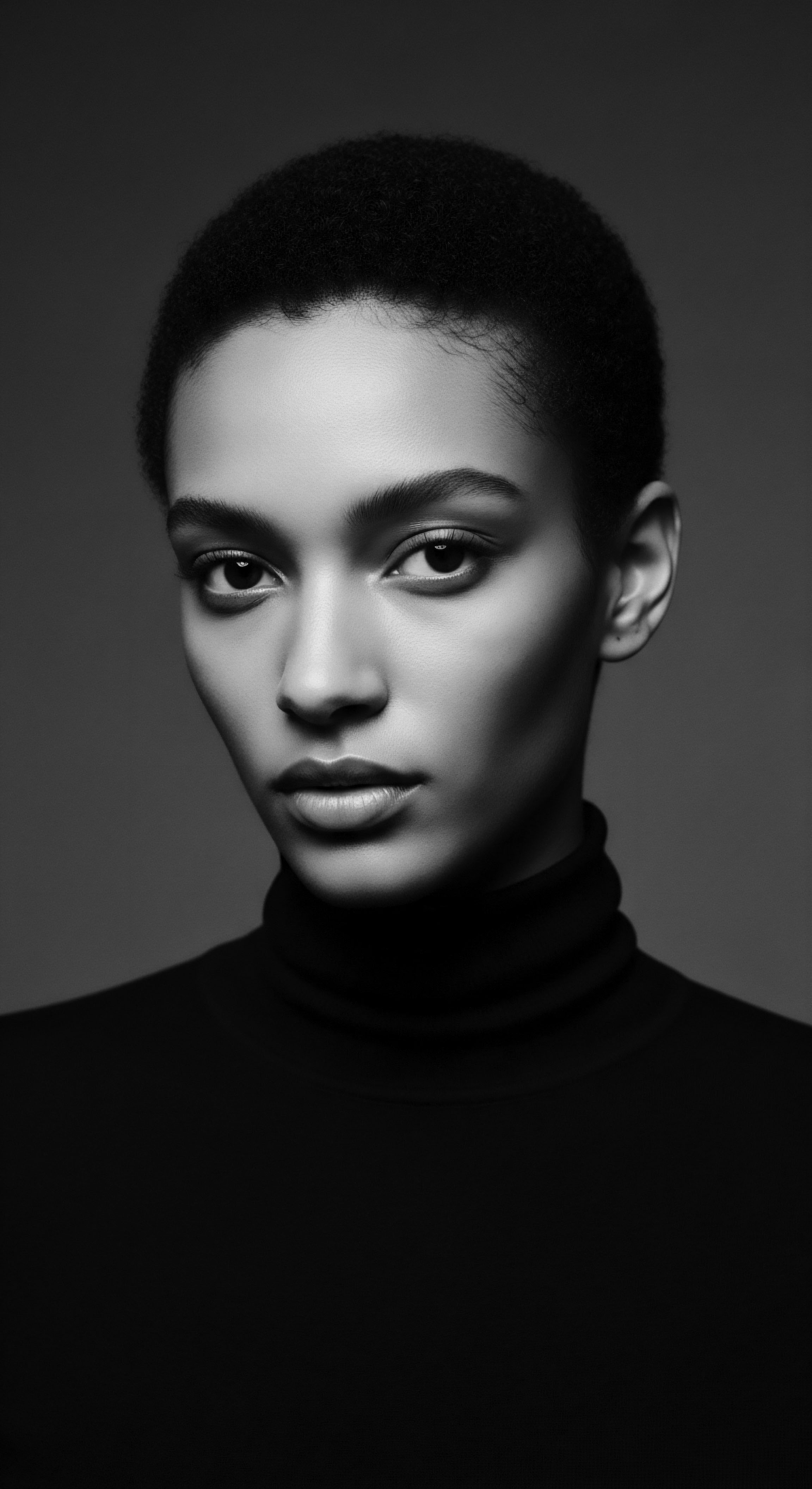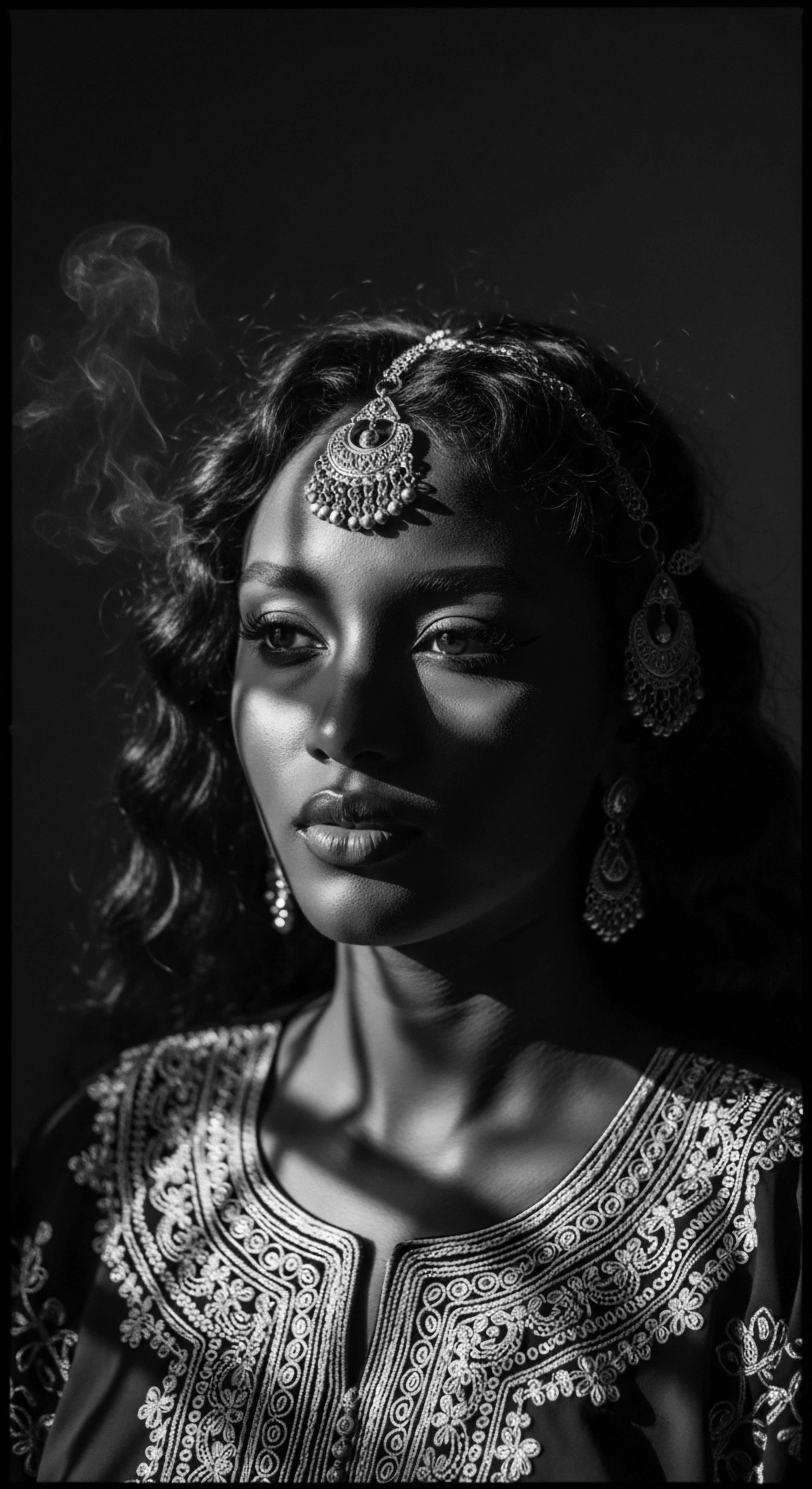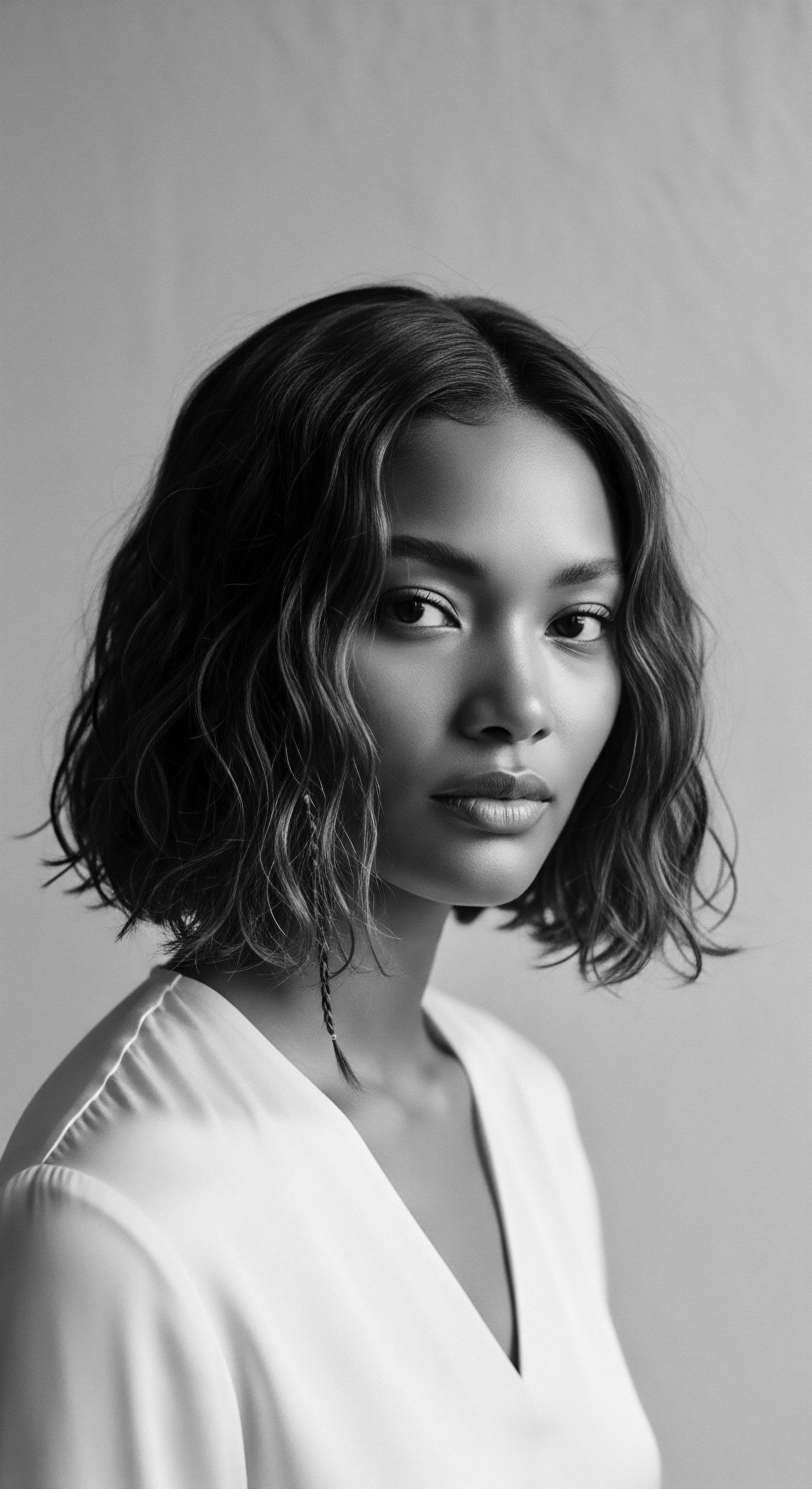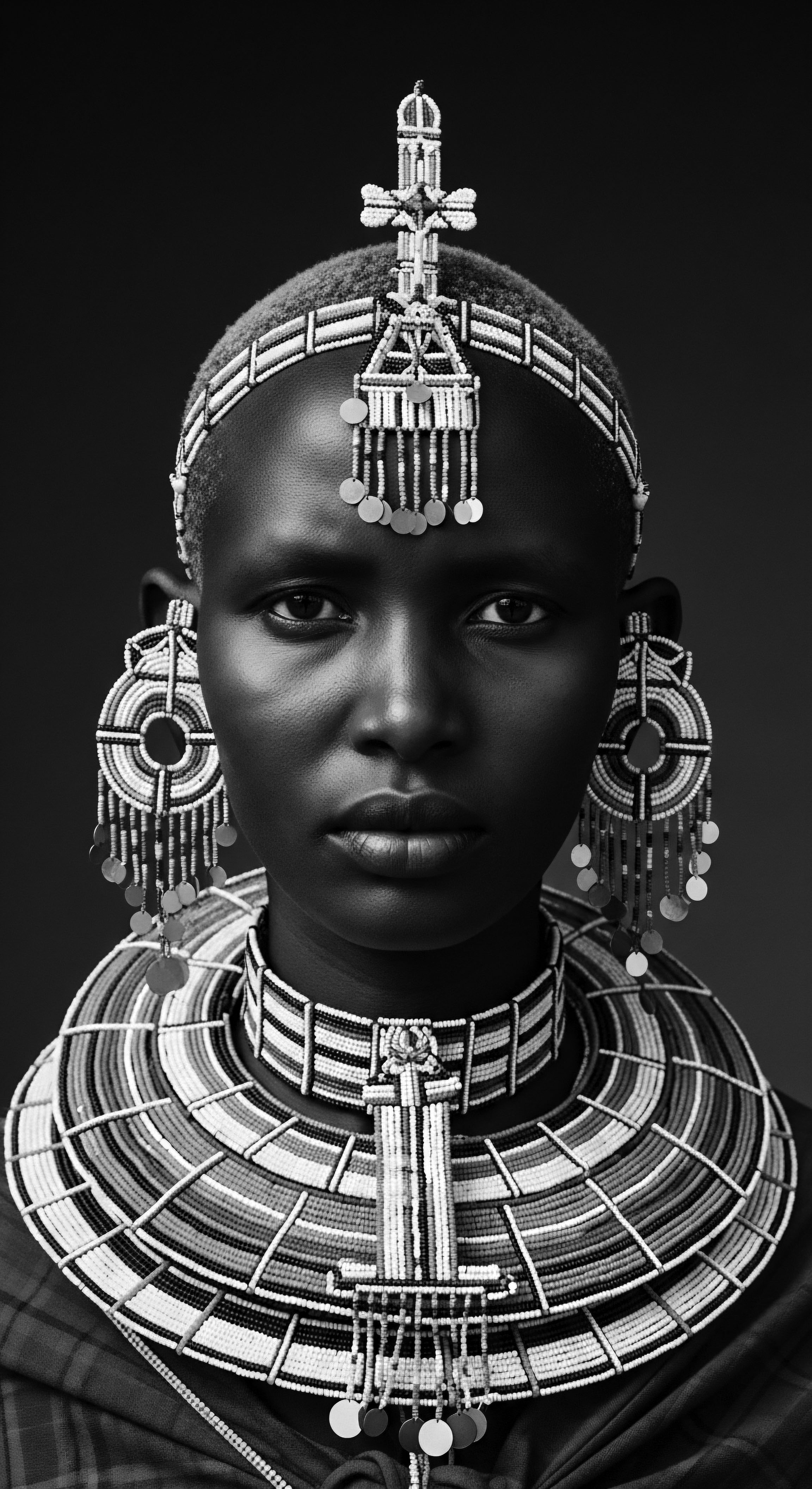
Fundamentals
The core meaning of ‘Textured Hair Needs’ refers to the distinct requirements for care and attention that hair with a discernible curl, coil, or wave pattern demands. This encompasses the unique structural characteristics of such hair, setting it apart from straight strands. It speaks to the inherent qualities of hair that shape its interaction with moisture, its resilience, and its inherent inclinations. The delineation of these needs recognizes that hair is not a monolithic entity; rather, it manifests in a rich spectrum of forms, each possessing its own particularities.
From the very source, our hair’s configuration is a whisper from our lineage, a genetic blueprint unfolding into coils, curls, and waves. These formations arise from the shape of the hair follicle itself—an oval or elliptical follicle yields textured strands, unlike the round follicle that produces straight hair. This biological foundation, a gift from our ancestors, directly impacts how moisture travels along the hair shaft, how strands interact with one another, and their inherent strength.
Understanding these foundational elements allows us to approach textured hair not as a challenge, but as a living inheritance with specific, yet discernible, requirements for flourishing. The explication of ‘Textured Hair Needs’ therefore begins with an acknowledgment of this biological ancestry, recognizing that our hair’s texture is a direct link to the earth and the stories of those who walked before us.
Textured Hair Needs signify the unique biological and historical requirements for the vitality of hair bearing natural curl, coil, or wave patterns.

Echoes from the Source ❉ The Biology of Textured Hair
The very architecture of textured hair, particularly in Black and mixed-race communities, tells a profound story of adaptation and resilience. Each strand, a testament to genetic heritage, emerges from a follicle that is typically elliptical or oval, dictating the hair’s characteristic helical growth. This shape causes the hair shaft to twist as it grows, creating the signature curl or coil patterns. The twists and turns, while beautiful, present inherent differences in how moisture is distributed along the strand.
Natural oils produced by the scalp, known as sebum, travel down a straight hair shaft with ease, offering continuous lubrication. On a coily or curly strand, however, the path is circuitous, meaning sebum struggles to reach the ends, often leaving them more susceptible to dryness. This inherent tendency towards dryness forms a primary consideration in understanding the care requirements for textured hair.
Beyond moisture distribution, the very structure of textured hair contributes to its distinct requirements. The points where the hair bends along its curl pattern are inherently weaker, making these areas more prone to breakage if not handled with reverence. The density of textured hair, often appearing voluminous due to its coiled nature, can also lead to tangling if not managed with mindful detangling practices.
These biological specifications, far from being deficiencies, are integral aspects of its beauty and character. They are elemental truths that guide our understanding of how to honor and sustain these ancestral strands.
- Follicle Shape ❉ An oval or elliptical follicle produces the characteristic bends and twists seen in textured hair, dictating its unique curl pattern.
- Moisture Distribution ❉ The helical structure impedes the smooth travel of natural scalp oils, often leading to increased dryness, particularly at the ends.
- Breakage Vulnerability ❉ The natural points of curvature along the hair shaft are areas of mechanical weakness, necessitating gentle handling.

Ancient Practices ❉ Foundations of Care
Long before modern science illuminated the precise biology of textured hair, ancestral communities possessed an intuitive, deeply ingrained understanding of its requirements. Their practices, passed down through generations, speak to a profound wisdom regarding the hair’s delicate nature and its thirst for nourishment. These traditions, born from observation and sustained by communal knowledge, form the bedrock of ‘Textured Hair Needs’ as a concept rooted in heritage. For instance, the meticulous use of natural butters, oils, and herbs was not merely cosmetic; it was a ritual of preservation, a means of imparting moisture and strength to strands that defied gravity and embraced their coiled forms.
Consider the widespread application of shea butter across West Africa, a practice that continues to this day. This golden balm, extracted from the nuts of the shea tree, offers a rich source of fatty acids and vitamins, providing deep conditioning and a protective barrier against environmental stressors. Its traditional preparation and application highlight a holistic approach to hair care, where the act of anointing hair was often communal, fostering bonds and transmitting cultural stories alongside practical knowledge.
Similarly, the use of various plant-based infusions and poultices demonstrates an early recognition of the hair’s need for specific botanical compounds to maintain its vitality and shine. These historical approaches were often characterized by patience, repetition, and a deep respect for the gifts of the earth, embodying a profound understanding of what textured hair genuinely required for its sustained well-being.

Intermediate
The meaning of ‘Textured Hair Needs’ deepens as we consider its historical and cultural dimensions, moving beyond elemental biology to the living traditions that have shaped its care. This understanding is not simply about identifying a hair type; it is about acknowledging a lineage of care, resilience, and identity. The concept encompasses the specific methodologies, product considerations, and styling approaches that respect the integrity of curls, coils, and waves, particularly those of Black and mixed-race individuals.
It involves a shift in perspective from attempting to alter natural texture to supporting its inherent structure and beauty. The interpretation of these needs acknowledges the societal pressures that have historically sought to suppress natural hair, recognizing that true care is an act of reclamation and self-affirmation.
Within this expanded definition, the significance of moisture becomes even more pronounced. Due to the unique structure of textured hair, its outer layer, the cuticle, often remains slightly raised, allowing moisture to escape more readily than in straight hair. This characteristic means textured hair often feels drier and requires consistent, targeted hydration. The practical implications of this reality include the preference for creamy, emollient products, the judicious use of water as a primary hydrator, and the application of techniques that seal in moisture.
Moreover, the inherent spring and elasticity of textured hair, while contributing to its voluminous appearance, also make it susceptible to tangling and shrinkage. Recognizing these aspects allows for a more informed and respectful approach to styling and maintenance, one that honors the hair’s natural inclinations rather than working against them.
Understanding Textured Hair Needs involves recognizing the historical and cultural significance of hair texture, guiding specific care practices that honor its unique structure and promote its vitality.

The Tender Thread ❉ Living Traditions of Care
The tender thread of care for textured hair has been passed through generations, often in communal settings, reflecting a deep connection between hair rituals and social cohesion. These practices were not merely about hygiene; they served as conduits for cultural transmission, storytelling, and the strengthening of familial bonds. The meticulous processes of detangling, conditioning, and styling became moments of shared wisdom, where elders imparted not only techniques but also the historical weight and spiritual significance of hair. In many West African societies, for instance, hair styling sessions were extended affairs, allowing for conversation, the exchange of news, and the reinforcement of community ties.
Consider the tradition of communal hair care among women in various African communities. These gatherings, often spanning hours, involved gentle finger-detangling, the application of nourishing plant-based mixtures, and the creation of intricate styles. This was a space of intergenerational learning, where younger hands learned the delicate art of handling coils and curls from their mothers and grandmothers.
The collective experience transformed a practical necessity into a revered ritual, underscoring the communal aspect of beauty and well-being. The knowledge shared in these circles, ranging from specific herbal remedies to the proper tension for braids, represents an invaluable heritage of care, demonstrating a profound understanding of the hair’s requirements through lived experience and collective observation.

Product Philosophy and Styling Approaches
The particular needs of textured hair inform a distinct philosophy regarding product selection and styling methodologies. Given its propensity for dryness, products rich in emollients and humectants are often preferred. Ingredients such as shea butter, coconut oil, and various botanical extracts, many of which have ancestral roots in African hair care, are prized for their moisturizing and sealing properties. The careful application of these formulations aims to replenish lost moisture and create a protective barrier, supporting the hair’s integrity.
Styling textured hair also demands approaches that respect its natural curl pattern and minimize manipulation. Protective styles, such as braids, twists, and cornrows, have been a cornerstone of textured hair care for millennia, offering a means to safeguard delicate ends, reduce tangling, and promote length retention. These styles, far from being mere aesthetic choices, carry profound cultural meaning, often signifying social status, tribal affiliation, or marital status in pre-colonial African societies. Even today, they serve as a connection to heritage, allowing individuals to honor ancestral practices while caring for their hair.
The choice of styling tools, too, reflects these specific requirements, with wide-tooth combs and fingers favored over fine-tooth combs to prevent unnecessary breakage. This deliberate approach to products and styling reflects a deep appreciation for the unique attributes of textured hair, fostering its health and celebrating its innate beauty.
| Aspect of Care Moisture Retention |
| Ancestral Practice (Pre-Colonial Africa) Application of natural oils (e.g. shea butter, palm oil), plant extracts, and clay to seal and nourish. |
| Contemporary Approach (Roothea's Perspective) Use of rich conditioners, leave-ins, and stylers with humectants and emollients; 'LOC' or 'LCO' method (Liquid, Oil, Cream). |
| Aspect of Care Detangling |
| Ancestral Practice (Pre-Colonial Africa) Finger-detangling or use of wide-toothed wooden combs, often with water or natural lubricants during communal sessions. |
| Contemporary Approach (Roothea's Perspective) Gentle finger-detangling, wide-tooth combs, or detangling brushes on wet or damp hair, often saturated with conditioner. |
| Aspect of Care Scalp Health |
| Ancestral Practice (Pre-Colonial Africa) Herbal rinses, clay masks, and specific plant concoctions to cleanse and soothe the scalp. |
| Contemporary Approach (Roothea's Perspective) Sulfate-free cleansers, scalp massages, and targeted treatments to maintain a balanced microbiome. |
| Aspect of Care Protective Styling |
| Ancestral Practice (Pre-Colonial Africa) Intricate braids, twists, and wraps for longevity, cultural expression, and preservation of hair. |
| Contemporary Approach (Roothea's Perspective) Modern adaptations of braids, twists, buns, and updos to minimize manipulation and shield hair from elements. |
| Aspect of Care Hair Growth/Strength |
| Ancestral Practice (Pre-Colonial Africa) Rituals involving specific herbs (e.g. Chebe powder in Chad) and consistent, gentle handling over time. |
| Contemporary Approach (Roothea's Perspective) Focus on minimizing breakage through gentle handling, deep conditioning, and nutrient-rich products; emphasis on length retention. |
| Aspect of Care These parallels demonstrate a continuous thread of understanding, where ancient wisdom often aligns with modern scientific insights into the unique requirements of textured hair. |

Academic
The academic meaning of ‘Textured Hair Needs’ extends beyond mere cosmetic considerations, delving into its profound anthropological, sociological, and psychometric dimensions. It refers to the complex interplay of biological structure, historical subjugation, cultural expression, and the psychological impact of hair on individuals and communities, particularly those of African descent. This definition acknowledges that the requirements for textured hair care are not simply about hydration or detangling; they are deeply interwoven with narratives of identity, resistance, and self-acceptance, often within societal contexts that have historically devalued natural Black and mixed-race hair. It is a comprehensive explication that necessitates examining hair as a dynamic cultural artifact, a canvas for social meaning, and a site of enduring ancestral connection.
From a scholarly perspective, the unique morphology of textured hair, characterized by its elliptical cross-section and numerous twists along the shaft, renders it more susceptible to dryness and breakage compared to straight hair. The lower number of disulfide bonds at the points of curvature makes these areas mechanically weaker, increasing vulnerability to fracture under tension. This inherent structural reality means that standard hair care protocols, often developed for straight hair, prove inadequate, if not detrimental, to textured strands. Therefore, the ‘needs’ encompass specific biomechanical considerations, such as the necessity for low-manipulation styling, the avoidance of excessive heat, and the application of highly emollient formulations that mimic or supplement the natural sebum distribution.
Textured Hair Needs represent a complex interplay of inherent biological characteristics, historical societal pressures, and the profound cultural and psychological significance of hair, particularly within Black and mixed-race communities.

The Unbound Helix ❉ Identity and Societal Resonance
The historical trajectory of textured hair, particularly within the African diaspora, is a testament to its symbolic power and its role as a marker of identity. During the transatlantic slave trade, enslavers often shaved the heads of captured Africans, a brutal act designed to strip individuals of their cultural identity and sever ties to their heritage. This systematic erasure underscored the profound significance hair held in pre-colonial African societies, where elaborate styles conveyed age, marital status, social rank, and tribal affiliation.
Despite these dehumanizing efforts, enslaved people found ingenious ways to maintain aspects of their hair culture, often using hair to hide seeds for planting or to map escape routes to freedom, transforming their hair into a clandestine tool of resistance. This period marks a profound shift in the understanding of textured hair’s requirements, as its care became an act of defiance, a quiet assertion of humanity against unimaginable oppression.
A powerful historical example of this societal impact and the imposed ‘needs’ of textured hair can be found in the Tignon Laws of Louisiana, Enacted in 1786. These laws mandated that free women of color, who often styled their hair elaborately and wore it as a symbol of their growing social and economic status, were compelled to cover their hair with a ‘tignon’ or headscarf. This legislation was a direct attempt to diminish their perceived attractiveness and social standing, forcing them to outwardly display a sign of their ‘inferior’ racial status. The Tignon Laws illuminate how the care and presentation of textured hair were not simply personal choices but became sites of social control and racial hierarchy.
This legal imposition created a ‘need’ to conform, yet simultaneously sparked creative adaptations of headwraps, transforming a symbol of subjugation into one of continued cultural expression and resilience. This historical instance underscores how external societal pressures profoundly shape the perceived and actual needs of textured hair, extending far beyond the physiological.
The mid-20th century saw the rise of the ‘Black is Beautiful’ movement, which championed the embrace of natural hair textures as a political statement and a rejection of Eurocentric beauty standards. This cultural shift, while empowering, also highlighted a different set of ‘needs’ ❉ the need for specialized products that catered to natural textures, the need for education on how to care for hair that had been chemically altered for generations, and the need for societal acceptance and validation of diverse hair expressions. Contemporary research continues to illustrate the enduring impact of these historical narratives.
A 2020 study by Duke University and Michigan State University, for instance, found that Black women with natural hairstyles were perceived as less professional and less likely to be recommended for job interviews than candidates with straightened hair, underscoring the persistent, albeit evolving, societal pressures that shape the ‘needs’ of textured hair in professional settings. This research demonstrates that the journey of understanding and addressing textured hair needs is ongoing, continually informed by both historical context and present-day realities.

Ancestral Wisdom and Scientific Validation
The concept of ‘Textured Hair Needs’ also compels an academic exploration of how ancestral practices, often dismissed as folk remedies, find validation in modern scientific understanding. For generations, communities in Chad have used a mixture of Chebe powder, cherry seeds, and cloves to fortify hair, promoting length retention and reducing breakage. This practice, passed down through matriarchal lines, involves consistently coating the hair strands with the powdered mixture. While traditionally attributed to spiritual or mystical properties, contemporary analysis reveals that Chebe powder, derived from Croton gratissimus seeds, contains naturally occurring fats and minerals that are highly beneficial for hair strength and minimizing breakage in textured hair types.
The success of this ritual lies not in a ‘miracle product’ but in the consistent, low-manipulation application over time, which protects the delicate hair shaft from mechanical stress and environmental damage. This provides a powerful instance where ancient, ritualistic care aligns with modern scientific principles of hair preservation.
Moreover, the communal aspect of these ancestral hair rituals, such as those observed in West Africa, offers insights into the psychosocial ‘needs’ of textured hair care. These sessions provided not only practical grooming but also fostered intergenerational bonding, transmitted oral histories, and reinforced cultural identity. The shared experience of care contributed to a sense of belonging and collective well-being, demonstrating that hair care was never a solitary act but a communal endeavor with deep social significance.
This sociological perspective on ‘Textured Hair Needs’ highlights that emotional and community support are as vital as the physical products applied to the hair. The consistent application of these practices, often over hours, allowed for meticulous attention to each strand, which science now understands as crucial for minimizing friction and preserving the hair’s integrity.
- Structural Vulnerability ❉ The unique twists of textured hair, resulting from its elliptical follicle, create points of weakness along the shaft, making it prone to breakage.
- Moisture Imperative ❉ The raised cuticle and winding path of textured hair hinder natural sebum distribution, necessitating external hydration and sealing.
- Societal Impositions ❉ Historical and ongoing discrimination against natural hair shapes perceived needs, often driving practices of alteration for acceptance.
- Cultural Reclamation ❉ The modern natural hair movement addresses not only physical care but also the psychological and communal needs for self-acceptance and pride.
The ongoing academic discourse surrounding ‘Textured Hair Needs’ therefore transcends a simple product recommendation. It invites a rigorous examination of the hair’s biomechanics, a compassionate consideration of its historical journey through oppression and resistance, and a celebration of its enduring role as a vibrant expression of cultural identity. The continued exploration of this concept requires a multidisciplinary approach, drawing from trichology, anthropology, sociology, and psychology to paint a comprehensive portrait of hair that is both scientifically understood and deeply revered. The profound connection between hair, self, and collective memory underscores the enduring importance of honoring textured hair in all its forms.

Reflection on the Heritage of Textured Hair Needs
The journey through the definition of ‘Textured Hair Needs’ is not merely an intellectual exercise; it is a profound meditation on the enduring legacy etched into every coil, curl, and wave. From the elemental biology that whispers tales of ancient adaptation to the vibrant, living traditions of care passed through generations, our understanding of these needs is intrinsically linked to the soul of a strand. This exploration reveals that textured hair, particularly within Black and mixed-race communities, carries a heritage of resilience, a silent testament to the ingenuity and strength of those who navigated challenging histories. The care practices, whether ancient rituals or modern innovations, are not just about aesthetics; they are acts of remembrance, of honoring ancestral wisdom, and of affirming identity in a world that has often sought to diminish it.
The unbound helix of textured hair speaks volumes about self-expression, community, and the shaping of futures. It reminds us that hair is a powerful canvas, capable of conveying stories, signifying belonging, and acting as a symbol of defiance. As we continue to learn and grow, our approach to textured hair care evolves, yet it remains firmly rooted in the reverence for its unique qualities and the rich cultural narratives it embodies. Each decision to moisturize, detangle with gentleness, or style with pride becomes a continuation of a sacred lineage, a dialogue between past and present.
The recognition of ‘Textured Hair Needs’ thus becomes a celebration of inherent beauty, a deep respect for heritage, and a hopeful declaration for generations to come. It is a continuous unfolding of love and understanding for a crown that has always carried profound meaning.

References
- Afriklens. (2024). African Hairstyles ❉ Cultural Significance and Legacy.
- Oforiwa, A. (2023). The History and Culture of African Natural Hair ❉ From Ancient Times to Modern Trends. AMAKA Studio.
- The Kurl Kitchen. (2024). The Cultural Significance Of Natural Hair In Different Communities.
- Adjoaa. (2024). The Recent History of Hair in Afro-American Culture.
- The Gale Review. (2021). African Hairstyles – The “Dreaded” Colonial Legacy.
- Noireônaturel. (2024). How frizzy hair saved the lives of slaves.
- African American Museum of Iowa. (n.d.). History of Hair.
- Dream Hair Care LLC. (2023). The History and Cultural Significance of Braiding.
- Smith Scholarworks. (n.d.). The natural hair transformation ❉ a journey of resilience and resistance.
- Issuu. (n.d.). Celebrating the history and beauty of afro-textured hair.
- Kodd Magazine. (n.d.). African hair tells a story and inspires the future.
- JSTOR Daily. (2019). How Natural Black Hair at Work Became a Civil Rights Issue.
- Byrdie. (2022). The Crown We Never Take Off ❉ A History of Black Hair Through the Ages.
- Legal Defense Fund. (2022). Don’t touch my hair! ❉ A guide to investigating race-based hair discrimination.
- Joanna Colomas. (2023). Unlock Ancient Hair Care Secrets ❉ Discover Global Rituals for Lustrous Locks.
- Premium Beauty News. (2024). Ancestral hair-paste ritual gains new life in Chad.
- Ascension. (2021). Chébé ❉ The ancient hair care ritual of Chad courtesy of Salwa Petersen.
- Marie Claire Nigeria. (2025). 5 timeless beauty rituals from across Africa.
- Haku Holistics. (2023). The Art of African Braiding ❉ A Historical Deep Dive.
